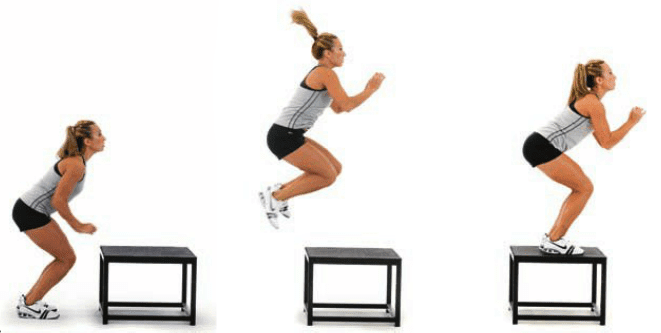Let’s all delve into the world of plyometrics, a powerful training methodology that can take your athletic performance to new heights. Plyometrics, often referred to as “jump training” or “plyos,” involves rapid contraction and extension of muscles, aimed at improving power, speed, and overall athletic performance.
At its core, plyometrics taps into the concept of the stretch-shortening cycle (SSC). This cycle involves three phases: the eccentric phase (muscle lengthening), the amortization phase (transition from lengthening to shortening), and the concentric phase (muscle shortening).
Plyometric exercises exploit this cycle to enhance the efficiency of muscle contraction, resulting in greater force production.
Examples of Plyometric Exercises
1. Box Jumps:
Execution: Stand in front of a sturdy box, bend your knees, and jump onto the box.
Benefits: Enhances explosive power in the lower body and improves overall jump height.
2. Depth Jumps:
Execution: Step off a box, immediately upon landing, jump vertically or horizontally.
Benefits: Develops rapid force production and improves reactive strength.
3. Medicine Ball Throws:
Execution: Explosively throw a medicine ball against a wall or to a partner.
Benefits: Targets upper body power, particularly in the shoulders and core.
4. Bounding:
Execution: Perform exaggerated, powerful strides covering as much ground as possible.
Benefits: Enhances coordination, agility, and explosive strength.
Key Principles
1. Quality Over Quantity: Plyometrics is about explosive, controlled movements. Always prioritize proper form over the number of repetitions.
2. Progression is Key: Begin with foundational exercises and gradually progress to more advanced ones. This ensures that your body adapts progressively, reducing the risk of injury.
3. Rest and Recovery: Plyometric training is intense; adequate rest between sessions is crucial. Muscles need time to recover and adapt to the increased demands.
4. Individualization: Tailor plyometric workouts to your specific sport or fitness goals. The demands on a basketball player will differ from those on a sprinter.
Benefits of Plyometric Training
1. Increased Power: Plyometrics enhance the ability to generate force quickly, translating to improved power in various athletic movements.
2. Improved Athletic Performance: Whether you’re a basketball player striving for a higher jump or a sprinter aiming for faster starts, plyometrics can significantly enhance specific aspects of athletic performance.
3. Injury Prevention: Strengthening the muscles, tendons, and ligaments through plyometrics can contribute to injury prevention by improving overall joint stability.
Safety Considerations
Before embarking on a plyometric training program, it’s crucial to ensure that you are in good health and have a solid fitness foundation.
If you have any pre-existing medical conditions or injuries, it’s advisable to consult with a healthcare professional or fitness expert before incorporating plyometrics into your routine.
Read Also The Art of DIY Gifts: Crafting Meaningful Presents from the Heart
Sample Plyometric Workout Routine

Here’s a sample plyometric workout that covers both upper and lower body movements:
1. Warm-up (5-10 minutes):
1. Light jogging or skipping rope to increase heart rate
2. Dynamic stretches for major muscle groups
2. Lower Body Plyometrics:
1. Box Jumps: 3 sets of 8 reps
2. Depth Jumps: 3 sets of 6 reps
3. Bounding: 2 sets of 50 meters
3. Upper Body Plyometrics:
1. Medicine Ball Chest Pass: 3 sets of 10 reps
2. Medicine Ball Overhead Throw: 3 sets of 8 reps
3. Plyometric Push-Ups: 3 sets of 12 reps
4. Combined Movements:
1. Squat Jumps: 3 sets of 15 reps
2. Burpees: 3 sets of 10 reps
5. Cool Down (5-10 minutes):
1. Gentle static stretching for major muscle groups
2. Deep diaphragmatic breathing to promote relaxation
Progress Monitoring
Regularly assess your progress by tracking metrics such as jump height, sprint times, or overall performance in your sport. Adjust the intensity and volume of your plyometric training based on your evolving fitness levels.
In summary, plyometric training is a dynamic and effective tool that can elevate your fitness and athletic performance when incorporated thoughtfully into your overall training regimen.
By understanding the science behind plyometrics, adhering to key principles, and customizing your routine, you can unlock the benefits of improved power, agility, and overall athleticism.
Remember, patience and consistency are the keys to success in any training program. As you embark on your plyometric journey, listen to your body, prioritize safety, and enjoy the journey of continual improvement in your athletic abilities.
Whether you’re an aspiring athlete or a fitness enthusiast, plyometrics can be a game-changer in propelling you towards your goals.
Read Also All You Need to Know About Paint Waste Disposal
